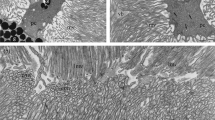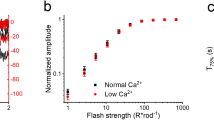Summary
Micromolar concentrations of silver ion activate large Ca2+ fluxes across the plasma membrane of intact rod outer segments isolated from bovine retinas (intact ROS). The rate of Ag+-induced Ca2+ efflux from intact ROS depended on the Ag+ concentration in a sigmoidal manner suggesting a cooperative mechanism with a Hill coefficient between 2 and 3. At a concentration of 50 μm Ag+ the rate of Ca2+ efflux was 7×106 Ca2+/outer segment/sec; this represents a change in total intracellular Ca2+ by 0.7mm/outer segment/sec. Addition of the nonselective ionophore gramicidin in the absence of external alkali cations greatly reduced the Ag+-induced Ca2+ efflux from intact ROS, apparently by enabling internal alkali cations to leak out. Adding back alkali cations to the external medium restored Ag+-induced Ca2+ efflux when gramicidin was present. In the presence of gramicidin, Ag+-induced Ca2+ efflux from intact ROS was blocked by 50 μm tetracaine orl-cis diltiazem, whereas without gramicidin both blockers were ineffective. Bothl-cis diltiazem and tetracaine are blockers of one kinetic component of cGMP-induced Ca2+ flux across ROS disk membranes. The ion selectivity of the Ag+-induced pathway proved to be broad with little discrimination between the alkali cations Li+, Na+, K+, and Cs+ or between Ca2+ and Mg2+. The properties of the Ag+-induced pathway(s) suggest that it may reflect the cGMP-dependent conductance opened in the absence of cGMP by silver ions.
Similar content being viewed by others
References
Abramson, J.J., Trimm, J.L., Weden, L., Salama, G. 1983. Heavy metals induce rapid calcium release from sarcoplasmic reticulum vesicles isolated from skeletal muscle.Proc. Natl. Acad. Sci. USA 80:1526–1530
Capovilla, M., Caretta, A., Cervetto, L., Torre, V. 1983. Ionic movements through light-sensitive channels of toad rods.J. Physiol. (London) 343:295–310
Fesenko, E.E., Kolesnikov, S.S., Lynbarsky, A.L. 1985. Induction by cyclic GMP of cationic conductance in plasma membrane of retinal rod outer segment.Nature (London) 313:310–313
Hodgkin, A.L., McNaughton, P.A., Nunn, B.J. 1985. The ionic selectivity and calcium dependence of the light-sensitive pathway in toad rods.J. Physiol. (London) 358:447–468
Hodgkin, A.L., McNaughton, P.A., Nunn, B.J. 1987. Measurement of sodium-calcium exchange in salamander rods.J. Physiol. (London) 391:347–370
Koch, K.-W., Cook, N.J., Kaupp, U.B. 1987. The cGMP-dependent channel of vertebrate rod photoreceptors exists in two forms of different cGMP sensitivity and pharmacological behaviour.J. Biol. Chem. 262:14415–14421
Koch, K.-W., Kaupp, U.B. 1985. Cyclic GMP directly regulates a cation conductance in membranes of bovine rods by a cooperative mechanism.J. Biol. Chem. 260:6788–6800
Koch, K.-W., Stryer, L. 1988. Highly cooperative feedback control of retinal rod guanylate cyclase by calcium ions.Nature (London) 334:64–66
Matthews, G. 1987. Single-channel recordings demonstrate that cGMP opens the light-sensitive ion channel of the rod photoreceptors.Proc. Natl. Acad. Sci. USA 84:299–302
Matthews, H.R., Murphy, R.L.W., Fain, G.L., Lamb, T.D. 1988. Photoreceptor light adaptation is mediated by cytoplasmic calcium concentration.Nature (London) 334:67–69
McLaughlin, S. 1977. Electrostatic potentials at membrane-solution interfaces.Curr. Top. Membr. Transp. 9:71–144
Myers, V.B., Haydon, D.A. 1972. Ion transfer across lipid membranes in the presence of gramicidin A.Biochim. Biophys. Acta 274:313–322
Nakatani, K., Yau, K.-W. 1988 Calcium and light adaptation in retinal rods and cones.Nature (London) 334:69–71
Oba, T., Hotta, K. 1985a. Silver ion-induced tension development and membrane depolarization in frog skeletal muscle fibres.Pfluegers Arch. 405:354–359
Oba, T., Hotta, K. 1985b. Tension development in frog skeletal muscle induced by silver ions.Jpn. J. Physiol. 35:841–851
Palade, P. 1987. Drug-induced Ca2+ release from isolated sarcoplasmic reticulum. II: Releases involving a Ca2+-induced Ca2+ release channel.J. Biol. Chem. 262:6142–6148
Salama, G., Abramson, J.J. 1984. Silver ions trigger Ca2+ release by acting at the apparent physiological release site in sarcoplasmic reticulum.J. Biol. Chem. 259:13363–13369
Schnetkamp, P.P.M. 1980. Ion selectivity of the cation transport system of isolated intact cattle rod outer segments: Evidence for a direct communication between the rod plasma membrane and the rod disk membranes.Biochim. Biophys. Acta 598:66–90
Schnetkamp, P.P.M. 1985a. Ca2+ buffer sites in intact bovine rod outer segments: Introduction to a novel optical probe to measure ionic permeabilities in suspensions of small particles.J. Membrane Biol. 88:249–262
Schnetkamp, P.P.M. 1985b. Ionic permeabilities of the plasma membrane of isolated intact bovine rod outer segments as studied with a novel optical probe.J. Membrane Biol. 88:263–275
Schnetkamp, P.P.M. 1986. Sodium-calcium exchange in the outer segments of bovine rod photoreceptors.J. Physiol. (London) 373:25–45
Schnetkamp, P.P.M. 1987. Sodium ions selectively eliminate the fast component of guanosine cyclic 3′, 5′-phosphate induced Ca2+ release from bovine rod outer segment disks.Biochemistry 26:3249–3253
Schnetkamp, P.P.M., Bownds, M.D. 1987. Na+- and cGMP-induced Ca2+ fluxes in frog rod photoreceptors.J. Gen. Physiol. 89:481–500
Schnetkamp, P.P.M., Daemen, F.J.M. 1981. Transfer of high-energy phosphate in bovine rod outer segments: A nucleotide buffer system.Biochim. Biophys. Acta 672:307–312
Schnetkamp, P.P.M., Kaupp, U.B., Junge, W., 1981. Interfacial potentials at the disk membranes of isolated intact cattle rod outer segments as a function of the occupation state of the intradiskal cation-exchange binding sites.Biochim. Biophys. Acta 642:213–230
Woodruff, M.L., Fain, G.L., Bastian, B.L. 1982. Light-dependent ion influx into toad photoreceptors.J. Gen. Physiol. 80:517–536
Yau, K.-W., Nakatani, K. 1984a. Cation selectivity of light-sensitive conductance in retinal rods.Nature (London) 309:352–354
Yau, K.-W., Nakatani, K. 1984b. Electrogenic Na−Ca exchange in retinal rod outer segment.Nature (London) 311:661–663
Yau, K.-W., Nakatani, K. 1985. Light-suppressible, cyclic GMP-sensitive conductance in the plasma membrane of a truncated rod outer segment.Nature (London) 317:252–255
Zimmerman, A.L., Yamanaka, G., Eckstein, F., Baylor, D.A., Stryer, L. 1985. Interaction of hydrolysis-resistant analogs of cyclic GMP with the phosphodiesterase and light-sensitive channel of retinal rod outer segments.Proc. Natl. Acad. Sci. USA 82:8813–8817
Author information
Authors and Affiliations
Rights and permissions
About this article
Cite this article
Schnetkamp, P.P.M., Szerencsei, R.T. Silver ions induce a rapid Ca2+ release from isolated intact bovine rod outer segments by a cooperative mechanism. J. Membrain Biol. 108, 91–102 (1989). https://doi.org/10.1007/BF01870428
Received:
Revised:
Issue Date:
DOI: https://doi.org/10.1007/BF01870428




